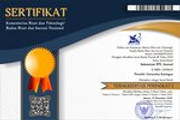EMPOWERING STUDENTS’ INTEGRATED LANGUAGE SKILLS THROUGH THE USE OF TEACHERS’ LEARNING VIDEOS IN BLENDED LEARNING CLASS
Abstract
Integrated language skills that applied with ITC-based learning is very important to teach as it helps students to be familiar to communicate English in the real situations. Meanwhile learning videos are part of ITC that are highly effective and efficient to help students to understand learning materials as well. The new normal era after the pandemic seems engaging both teachers and students to use learning videos in blended learning class which consists of varied learning interactions. The blended learning gives both teachers and students more opportunities to apply advanced technologies, so they get ready in facing society 5.0 era. This research is a case study of mixed method design. It aims to find out qualitatively and quantitatively to what extent the use of teachers’ learning videos in blended learning empower students’ integrated language skills. By doing questionnaires, interviews and having observation on 32 participants-the 2 teachers and 30 students of MTs. Negeri 6 Cianjur at the eighth grade, the data were collected and analyzed. The findings revealed that positive respond to the use of teachers' learning videos in MTs. N 6 Cianjur reached 81%, the use of blended learning class was 80% and students' integrated learning skills empowerments was 79%. These values are then averaged to 80%. Thus quantitatively the extent of students' integrated language skills empowerment through the use of teachers' learning videos in blended learning class is feasible. While the results of qualitative data analysis obtained from semi-structured interviews show that the data obtained can expand and deepen the quantitative data.
Keywords: blended learning; integrated language skills; learning videos; students’ empowerment.
Full Text:
PDFReferences
Ahmadzai, H.R. (2020). Integrating four skills in English language classroom in Afghan Universities. Instructor of English Department Language and Literature Faculty Parwan State University, 6(6), 1-2.
Akhmadjanovna, N.R, Abdukhalilovna, M.H & Habibullaevna, M.B. (2019), Integrated language skills into the process of the English language teaching. Вестник Науки И Образования, 19(73), 53-55.
Akmal, S., Masna, Y., Tria, M., & Maulida, T. A (2020). EFL teachers’ perceptions: Challenges and coping strategies of integrated skills approach (ISA). Indonesian Journal of English Language Teaching and Applied Linguistics, 4(2), 363-380.
Algizzawi, M., Habes, M., Salloum, S. A., Ghani, M. A., Mhamdi, C., & Shaalan, K. (2019). The effect of social media usage on students’ e-learning acceptance in higher education: A case study from the United Arab Emirates. International Journal of Information Technology and Language Studies (IJITLS), 3(3), 13-26.
Amanah, M. A. and Suwarso, P. N. (2022) The use of video as a media to improve students’ ability on English. Journal of English Language and Education, 7(1), 145-152.
Chaeruman, U. A. (2018). Pengembangan model desain sistem pembelajaran blended untuk program SPADA Indonesia [Unpublished dissertation]. Universtas Negeri Jakarta.
Chaeruman, U. A. and Maudiarti, S. (2018). Quadrant of blended learning: A proposed conceptual model for designing effective blended learning. Jurnal PembelajaranIinovatif, 1(1), 1-5.
Creswell, J.W. (2022). Educational research: Planning, conducting, and evaluating quantitative and qualitative research (6th Ed). Pearson.
Evans, M. B. (2018). The integration of reading, writing, speaking, and listening skills in the middle school social studies classroom [Unpublished dissertation]. Utah State University.
Handoko & Waskito. (2018). Blended learning: Konsep dan penerapannya. Multimedia Unand.
Hashemi, A. (2020) The effects of using blended learning in teaching and learning English: A review of literature. The Eurasia Proceedings of Educational & Social Sciences (EPESS), 18, 173-179.
Hendarita, Y. (2018). Model pembelajaran blended learning dengan media blog. Kemdikbud. https://sibatik.kemdikbud.go.id/inovatif/assets/file_upload/pengantar/pdf/pengantar_3.pdf
Jasmasyah. (2020). ICT in education: Teori dan praktik dalam Pendidikan. Zahira Publishing.
Ju, S.Y., & Mei, S.Y. (2018). Perceptions and practices of blended learning in foreign language teaching at USIM. European Journal of 38 Social Sciences Education and Research, 12(1), 170-176.
Mudra, H. (2018). Blended English language learning as a course in an Indonesian context: An exploration toward EFL learners’ perceptions. Journal of Foreign Language Education and Technology, 3(2), 28-51.
Nasution, N., Jalinus, N., & Syahril. (2019). Buku model blended learning. Unilak Press.
Nazara, S. (2019). ICT use in EFL classroom. In Pardede, P. (Ed.). English Education Department Collegiate Forum (EED CF) 2015-2018, UKI Press, 126-135.
Nazaralieva, M.A. (2020). Base of integrated skills in psychological principles of teaching English. Scientific Bulletin of Namangan State University, 2(11), 214-2018.
Nugraha, A. A. P. P. Y., & Widiana, I. W. (2021). Learning alternative energy using graphic video media. International Journal of Elementary Education, 5(2), 224-230.
Nurwahidah, C. D, Zaharah & Sina, I. (2021). Media video pembelajaran dalam meningkatkan motivasi dan prestasi mahasiswa. Rusyan Fikr, 17(1), 118-139.
Pardede, P (2019) Integrated skill approach in EFL classrooms: A literature review. Proceeding English Education Department Collegiate Forum (Eed Cf) 2015-2018 (pp.147-159). UKI Press.
Pardede, P (2019). Pre-service EFL teachers’ perception of edmodo use as a complementary learning tool. Proceeding English Education Department Collegiate Forum (EED CF) 2015-2018 (pp.29-41). UKI Press.
Patton, M. (2002). Qualitative research and evaluation methods (3rd ed.). Sage.
Putry, H. M. E., Adila, V. N., Sholeha, R., & Hilmi, D. (2020). Video based learning sebagai tren media pembelajaran di era 4.0. Tarbiyatuna: Jurnal Pendidikan Ilmiah , 5(1), 1-24.
Riduan. (2018). Skala pengukuran variabel-variabel penelitian. Alfabeta.
Rohana, S. Y., and Syahputra, A. (2021). Model pembelajaran blended learning pasca new normal covid-19. At-Ta’dib: Jurnal Ilmiah Prodi Pendidikan Agama Islam, 13(1), 48 – 59.
Sharma, C. (2021). The importance of four basic skills in learning English. Published article by Himalayan University, 7(4), 33-36.
Wardani, D. N., Toenlioe, A. J. E., & Wedi, A. (2018). Pembelajaran di era 21 dengan blended learning. JKTP, 1(1), 13-18.
Zainuddin, Z., Habiburrahim., Muluk, S., & Keumala, C. M. (2019). How do students become self-directed learners in the EFL flipped-class pedagogy? A study in higher education. Indonesian Journal of Applied Linguistics, 8(3), 678-690.
Zainuddin, Z., & Perera, C. J. (2018). Supporting students’ self-directed learning in the flipped classroom through the LMS TES Blend Space. On the Horizon, 26(4), 281-290.
DOI: https://doi.org/10.25134/ieflj.v9i1.7577
Refbacks
- There are currently no refbacks.

This work is licensed under a Creative Commons Attribution-ShareAlike 4.0 International License.

